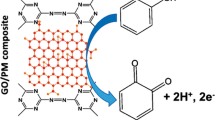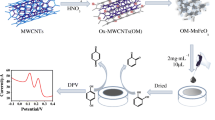Abstract
An electrochemical sensor is described for the simultaneous determination of the pollutants catechol (CC) and hydroquinone (HQ). A glassy carbon electrode (GCE) was modified with reduced graphene oxide, Fe3O4 and gold nanoparticles and then showed a pair of well-defined voltammetric peaks for CC and HQ. Its oxidation peak potentials (located at 0.21 and 0.10 V vs. Ag/AgCl) are well separated, and this makes it suitable for simultaneous determination of the two isomers. Under optimal conditions, the oxidation peak currents of CC and HQ increase linearly in the 0.05–550 μM and 0.1–500 μM concentration ranges, even in the presence of 0.1 mM of the respective other isomer. The detection limits are 0.02 and 0.17 μM (at S/N = 3), respectively. The modified GCE exhibits good selectivity and recovery when applied for the analysis of spiked wastewater.

Ternary hybrid nanomaterials of rGO-Fe3O4-Au was developed for simultaneous electrochemical determination of catechol (CC) and hydroquinone (HQ).





Similar content being viewed by others
References
Guo Q, Huang J, Chen P, Liu Y, Hou H, You T (2012) Simultaneous determination of catechol and hydroquinone using electrospun carbon nanofibers modified electrode. Sensors Actuators B Chem 163:179–185
Si W, Lei W, Zhang Y, Xia M, Wang F, Hao Q (2012) Electrodeposition of graphene oxide doped poly (3, 4-ethylenedioxythiophene) film and its electrochemical sensing of catechol and hydroquinone. Electrochim Acta 85:295–301
Ahammad AS, Rahman MM, Xu GR, Kim S, Lee JJ (2011) Highly sensitive and simultaneous determination of hydroquinone and catechol at poly (thionine) modified glassy carbon electrode. Electrochim Acta 56:5266–5271
Shen Y, Rao D, Sheng Q, Zheng J (2017) Simultaneous voltammetric determination of hydroquinone and catechol by using a glassy carbon electrode modified with carboxy-functionalized carbon nanotubes in a chitosan matrix and decorated with gold nanoparticles. Microchim Acta 184:3591–3601
Huang W, Zhang T, Hu X, Wang Y, Wang J (2018) Amperometric determination of hydroquinone and catechol using a glassy carbon electrode modified with a porous carbon material doped with an iron species. Microchim Acta 185(1):37–44
Liu Z, Wang Z, Cao Y, Jing Y, Liu Y (2011) High sensitive simultaneous determination of hydroquinone and catechol based on graphene/BMIMPF6 nanocomposite modified electrode. Sensors Actuators B Chem 157:540–546
Hatamluyi B, Lorestani F, Es’haghi Z (2018) Au/Pd@rGO nanocomposite decorated with poly (L-cysteine) as a probe for simultaneous sensitive electrochemical determination of anticancer drugs, ifosfamide and etoposide. Biosens Bioelectron 120:22–29
Liu C, Huang J, Wang L (2018) Electrochemical synthesis of a nanocomposite consisting of carboxy-modified multi-walled carbon nanotubes, polythionine and platinum nanoparticles for simultaneous voltammetric determination of myricetin and rutin. Microchim Acta 185:414–424
Baghayeri M, Amiri A, Maleki B, Alizadeh Z, Reiser O (2018) A simple approach for simultaneous detection of cadmium (II) and lead (II) based on glutathione coated magnetic nanoparticles as a highly selective electrochemical probe. Sensors Actuators B Chem 273:1442–1450
Pungjunun K, Chaiyo S, Jantrahong I, Nantaphol S, Siangproh W, Chailapakul O (2018) Anodic stripping voltammetric determination of total arsenic using a gold nanoparticle-modified boron-doped diamond electrode on a paper-based device. Microchim Acta 185:324–332
Zhu Y, Murali S, Cai W, Li X, Suk JW, Potts JR, Ruoff RS (2010) Graphene and graphene oxide: synthesis, properties, and applications. Adv Mater 22:3906–3924
Teo PS, Lim HN, Huang NM, Chia CH, Harrison I (2012) Room temperature in situ chemical synthesis of Fe3O4/graphene. Ceram Int 38:6411–6416
Peng D, Hu B, Kang M, Wang M, He L, Zhang Z, Fang S (2016) Electrochemical sensors based on gold nanoparticles modified with rhodamine B hydrazide to sensitively detect cu (II). Appl Surf Sci 390:422–429
Jana NR, Gearheart L, Murphy CJ (2001) Wet chemical synthesis of high aspect ratio cylindrical gold nanorods. J Phys Chem B 105:4065–4067
Kong FY, Li WW, Wang JY, Wang W (2015) UV-assisted photocatalytic synthesis of highly dispersed Ag nanoparticles supported on DNA decorated grapheme for quantitative iodide analysis. Biosens Bioelectron 69:206–212
Zheng J, Dong Y, Wang W, Ma Y, Hu J, Chen X, Chen X (2013) In-situ loading of gold nanoparticles on Fe3O4@SiO2 magnetic nanocomposites and their high catalytic properties. Nanoscale 5:4894–4901
Shoaie N, Forouzandeh M, Omidfar K (2018) Voltammetric determination of the Escherichia coli DNA using a screen-printed carbon electrode modified with polyaniline and gold nanoparticles. Microchim Acta 185:217–226
Zhang Y, Xiao J, Sun Y, Wang L, Dong X, Ren J, Xiao F (2018) Flexible nanohybrid microelectrode based on carbon fiber wrapped by gold nanoparticles decorated nitrogen doped carbon nanotube arrays: in situ electrochemical detection in live cancer cells. Biosens Bioelectron 100:453–461
Maduraiveeran G, Ramaraj R (2007) Gold nanoparticles embedded in silica sol-gel matrix as an amperometric sensor for hydrogen peroxide. J Electroanal Chem 608:52–58
Zeng T, Ma YR, Niu HY, Cai YQ (2012) A novel Fe3O4-graphene-Au multifunctional nanocomposite: green synthesis and catalytic application. J Mater Chem 22:18658–18663
Hu M, Chen J, Li ZY, Au L, Hartland GV, Li X, Xia Y (2006) Gold nanostructures: engineering their plasmonic properties for biomedical applications. Chem Soc Rev 35:1084–1094
Kong FY, Li XR, Zhao WW, Xu JJ, Chen HY (2012) Graphene oxide-thionine-Au nanostructure composites: preparation and applications in non-enzymatic glucose sensing. Electrochem Commun 14:59–62
Bohren CF, Huffman DR (1983) Absorption and scattering of light by small particles. Wiley, New York
Fan L, Li X, Kan X (2016) Disposable graphite paper based sensor for sensitive simultaneous determination of hydroquinone and catechol. Electrochim Acta 213:504–511
Zheng L, Xiong L, Li Y, Xu J, Kang X, Zou Z, Yang S, Xia J (2013) Facile preparation of polydopamine-reduced graphene oxide nanocomposite and its electrochemical application in simultaneous determination of hydroquinone and catechol. Sensors Actuators B Chem 177:344–349
Huang YH, Chen JH, Sun X, Su ZB, Xing HT, Hu SR, Weng W, Guo HX, Wu WB, He YS (2015) One-pot hydrothermal synthesis carbon nanocages-reduced graphene oxide composites for simultaneous electrochemical detection of catechol and hydroquinone. Sensors Actuators B Chem 212:165–173
Mao H, Liu M, Cao Z, Ji C, Sun Y, Liu D, Wu S, Zhang Y, Song XM (2017) Poly (4-vinylphenylboronic acid) functionalized polypyrrole/graphene oxide nanosheets for simultaneous electrochemical determination of catechol and hydroquinone. Appl Surf Sci 420:594–605
Buleandra M, Rabinca AA, Badea IA, Balan A, Stamatin I, Mihailciuc C, Ciucu AA (2017) Voltammetric determination of dihydroxybenzene isomers using a disposable pencil graphite electrode modified with cobalt-phthalocyanine. Microchim Acta 184:1481–1488
Wang X, Xi M, Guo M, Sheng F, Xiao G, Wu S, Matsuura H (2016) An electrochemically aminated glassy carbon electrode for simultaneous determination of hydroquinone and catechol. Analyst 141:1077–1082
Velmurugan M, Karikalan N, Chen SM, Cheng YH, Karuppiah C (2017) Electrochemical preparation of activated graphene oxide for the simultaneous determination of hydroquinone and catechol. J Colloid Interface Sci 500:54–62
Alshahrani LA, Liu L, Sathishkumar P, Nan J, Gu FL (2018) Copper oxide and carbon nano-fragments modified glassy carbon electrode as selective electrochemical sensor for simultaneous determination of catechol and hydroquinone in real-life water samples. J Electroanal Chem 815:68–75
Zhao L, Yu J, Yue S, Zhang L, Wang Z, Guo P, Liu Q (2018) Nickel oxide/carbon nanotube nanocomposites prepared by atomic layer deposition for electrochemical sensing of hydroquinone and catechol. J Electroanal Chem 808:245–251
Goulart LA, Gonçalves R, Correa AA, Pereira EC, Mascaro LH (2018) Synergic effect of silver nanoparticles and carbon nanotubes on the simultaneous voltammetric determination of hydroquinone, catechol, bisphenol A and phenol. Microchim Acta 185:12–21
Acknowledgments
This work was supported by the National Natural Science Foundation of China (21575123, 21675139, 21603184, 21705140), the Natural Science Foundation of Jiangsu Province (BK20170474), the opening project of Jiangsu Key Laboratory of Biochemistry and Biotechnology of Marine Wetland (K2016-17, K2016-20), and Qing Lan Project.
Author information
Authors and Affiliations
Corresponding author
Ethics declarations
The author(s) declare that they have no competing interests.
Additional information
Publisher’s note
Springer Nature remains neutral with regard to jurisdictional claims in published maps and institutional affiliations.
Electronic supplementary material
ESM 1
(DOC 1033 kb)
Rights and permissions
About this article
Cite this article
Kong, FY., Li, RF., Yao, L. et al. Voltammetric simultaneous determination of catechol and hydroquinone using a glassy carbon electrode modified with a ternary hybrid material composed of reduced graphene oxide, magnetite nanoparticles and gold nanoparticles. Microchim Acta 186, 177 (2019). https://doi.org/10.1007/s00604-019-3273-4
Received:
Accepted:
Published:
DOI: https://doi.org/10.1007/s00604-019-3273-4




